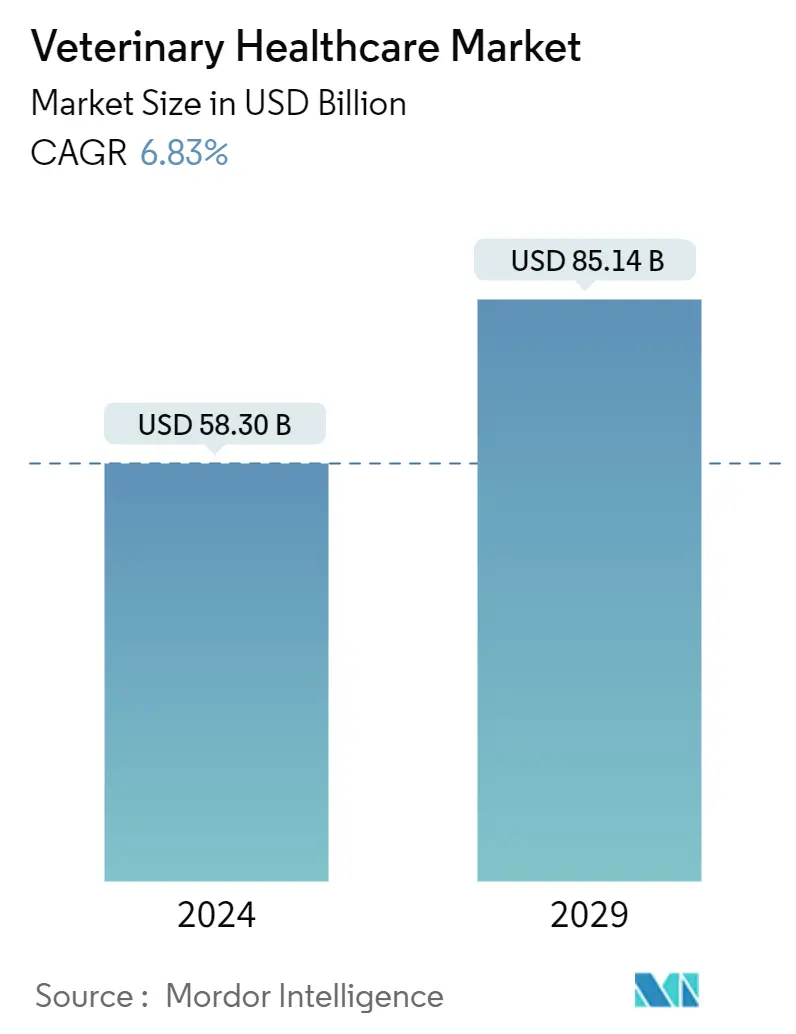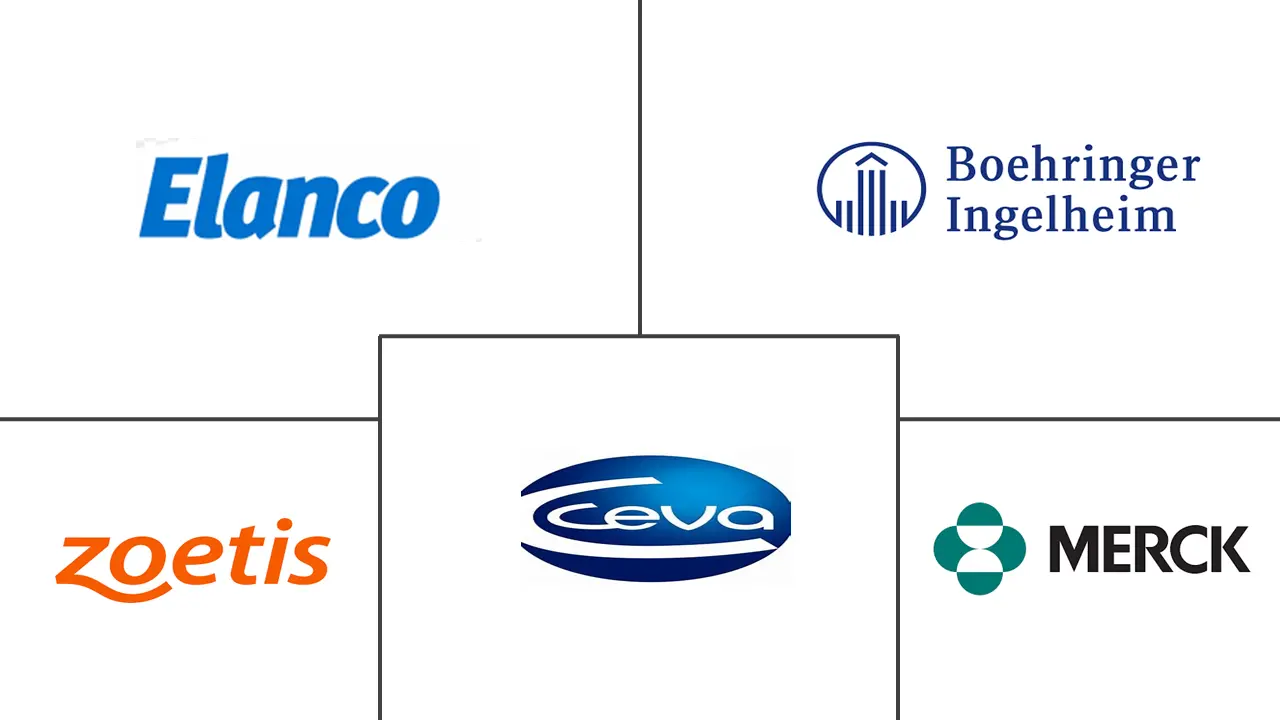Market Size of Veterinary Healthcare Industry

| Study Period | 2019 - 2029 |
| Market Size (2024) | USD 58.30 Billion |
| Market Size (2029) | USD 85.14 Billion |
| CAGR (2024 - 2029) | 6.83 % |
| Fastest Growing Market | Asia-Pacific |
| Largest Market | North America |
| Market Concentration | Medium |
Major Players
*Disclaimer: Major Players sorted in no particular order |
Veterinary Healthcare Market Analysis
The Veterinary Healthcare Market size is estimated at USD 58.30 billion in 2024, and is expected to reach USD 85.14 billion by 2029, growing at a CAGR of 6.83% during the forecast period (2024-2029).
The major factors driving the market are the increasing prevalence of zoonotic diseases, rising awareness of animal health, technological advancements in animal healthcare diagnostics, and increasing government initiatives by the Global Veterinary Medical Association.
Zoonotic diseases are infections that are spread between people and animals. The rising prevalence of zoonotic diseases will likely drive market growth during the forecast period. For instance, in the study published by the Federal Research Institute for Animal Health in January 2024, between December 1 and December 31, 2023, 13 HPAIV H5 outbreaks were detected in domestic poultry in Germany. The number of Avian Influenza cases in wild birds increased in 2023 compared to 2022. In addition, according to the study published by the European Centre for Disease Prevention and Control, between June 24 and September 1, 2023, highly pathogenic avian influenza (HPAI) A(H5) outbreaks were reported in domestic and wild birds across 21 countries in Europe. Hence, the rising prevalence of zoonotic disease worldwide will lead to more focus on animal health, ultimately increasing the demand for veterinary healthcare.
The growing technological advancements in animal healthcare diagnostics are expected to drive the market. For instance, in November 2023, IDEXX Laboratories Inc. launched the SNAP Leish 4Dx test, a comprehensive screening test for vector-borne diseases, including canine leishmaniosis. The new test was expected to be available in Europe and Asia starting from February 2024. In June 2023, IDEXX launched the first test for detecting kidney injury in cats and dogs called the IDEXX Cystatin B test. Hence, the rising technological advancements in animal healthcare are expected to drive the market during the forecast period.
However, the high cost of diagnostic imaging equipment and veterinary medicines and the high price of veterinary services are anticipated to restrain market growth over the forecast period.
Veterinary Healthcare Industry Segmentation
As per the report's scope, veterinary healthcare can be defined as the science associated with diagnosing, treating, and preventing animal diseases. The increasing importance of the production of livestock animals is boosting market growth.
The veterinary healthcare market is segmented by product, animal type, and geography. By product, the market is segmented into therapeutics and diagnostics. By animal type, the market is segmented into dogs, cats, horses, ruminants, swine, poultry, and other animal types. By geography, the market is segmented into North America, Europe, Asia-Pacific, the Middle East and Africa, and South America. The report also covers the estimated sizes and trends for 17 countries across major regions globally. The report offers the value (USD) for all the above segments.
| By Product | |||||||
| |||||||
|
| By Animal Type | |
| Dogs and Cats | |
| Horses | |
| Ruminants | |
| Swine | |
| Poultry | |
| Other Animal Types |
| By Geography | ||||||||
| ||||||||
| ||||||||
| ||||||||
| ||||||||
|
Veterinary Healthcare Market Size Summary
The veterinary healthcare market is poised for significant growth, driven by the introduction of new products and innovations aimed at treating animal disorders. The market has rebounded to pre-pandemic levels, with increasing demand for veterinary health products and services. This resurgence is attributed to the approval of advanced veterinary products, such as DechraVeterinary Products' VETRADENT Liquid Water Additive and BASF's Mobile Near Infrared Spectroscopy Solution. These developments, alongside strategic acquisitions and expansions by key players like R-BiopharmAG and IDEXX Laboratories, are expected to propel the market forward. However, challenges such as the high cost of diagnostic imaging equipment and veterinary medicines may pose constraints to market growth.
North America remains a dominant region in the veterinary healthcare market, supported by high pet adoption rates and proactive initiatives by organizations like Best Friends Animal Society and the California Animal Welfare Funders Collaborative. These efforts, coupled with increased consumer spending on pet healthcare, are driving market expansion. The introduction of new vaccines and treatments, such as Merck Animal Health's initiatives and Zoetis' FDA-approved products, further underscores the market's growth trajectory. Major companies are actively engaging in regional expansions, mergers, and collaborative research to enhance their competitive edge, ensuring a robust market landscape over the forecast period.
Veterinary Healthcare Market Size - Table of Contents
-
1. MARKET DYNAMICS
-
1.1 Market Overview
-
1.2 Market Drivers
-
1.2.1 Advanced Technologies Leading to Innovations in Animal Healthcare
-
1.2.2 Increasing Initiatives by Governments and Animal Welfare Associations Globally
-
1.2.3 Increasing Productivity at the Risk of Emerging Zoonosis
-
-
1.3 Market Restraints
-
1.3.1 High Cost of Diagnostic Imaging Equipment and Veterinary Medicines
-
1.3.2 High Price of Veterinary Services
-
-
1.4 Porter's Five Forces Analysis
-
1.4.1 Threat of New Entrants
-
1.4.2 Bargaining Power of Buyers/Consumers
-
1.4.3 Bargaining Power of Suppliers
-
1.4.4 Threat of Substitute Products
-
1.4.5 Intensity of Competitive Rivalry
-
-
-
2. MARKET SEGMENTATION (Market Size by Value - USD)
-
2.1 By Product
-
2.1.1 Therapeutics
-
2.1.1.1 Vaccines
-
2.1.1.2 Parasiticides
-
2.1.1.3 Anti-infectives
-
2.1.1.4 Medical Feed Additives
-
2.1.1.5 Other Therapeutics
-
-
2.1.2 Diagnostics
-
2.1.2.1 Immunodiagnostic Tests
-
2.1.2.2 Molecular Diagnostics
-
2.1.2.3 Diagnostic Imaging
-
2.1.2.4 Clinical Chemistry
-
2.1.2.5 Other Diagnostics
-
-
-
2.2 By Animal Type
-
2.2.1 Dogs and Cats
-
2.2.2 Horses
-
2.2.3 Ruminants
-
2.2.4 Swine
-
2.2.5 Poultry
-
2.2.6 Other Animal Types
-
-
2.3 By Geography
-
2.3.1 North America
-
2.3.1.1 United States
-
2.3.1.2 Canada
-
2.3.1.3 Mexico
-
-
2.3.2 Europe
-
2.3.2.1 France
-
2.3.2.2 Germany
-
2.3.2.3 United Kingdom
-
2.3.2.4 Italy
-
2.3.2.5 Spain
-
2.3.2.6 Rest of Europe
-
-
2.3.3 Asia-Pacific
-
2.3.3.1 China
-
2.3.3.2 Japan
-
2.3.3.3 India
-
2.3.3.4 Australia
-
2.3.3.5 South Korea
-
2.3.3.6 Rest of Asia-Pacific
-
-
2.3.4 Middle East and Africa
-
2.3.4.1 GCC
-
2.3.4.2 South Africa
-
2.3.4.3 Rest of Middle East and Africa
-
-
2.3.5 South America
-
2.3.5.1 Brazil
-
2.3.5.2 Argentina
-
2.3.5.3 Rest of South America
-
-
-
Veterinary Healthcare Market Size FAQs
How big is the Veterinary Healthcare Market?
The Veterinary Healthcare Market size is expected to reach USD 58.30 billion in 2024 and grow at a CAGR of 6.83% to reach USD 85.14 billion by 2029.
What is the current Veterinary Healthcare Market size?
In 2024, the Veterinary Healthcare Market size is expected to reach USD 58.30 billion.

